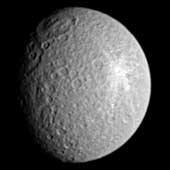|
COMETS EARTH JUPITER KUIPER BELT MARS MERCURY METEORITES NEPTUNE OORT CLOUD PLUTO SATURN SOLAR SYSTEM SPACE SUN URANUS VENUS ORDER PRINTS
PHOTO CATEGORIES SCIENCEVIEWS AMERICAN INDIAN AMPHIBIANS BIRDS BUGS FINE ART FOSSILS THE ISLANDS HISTORICAL PHOTOS MAMMALS OTHER PARKS PLANTS RELIGIOUS REPTILES SCIENCEVIEWS PRINTS
|
Related Documents
Download Options
Saturn's moon Rhea displays two large impact features here, along the terminator (the boundary between day and night), plus a superb rayed crater to the east. Rhea is 1,528 kilometers (949 miles) across. The northern basin, named Tirawa, was discovered in Voyager images. This ancient impact site is approximately 360 kilometers (220 miles) across. Another, perhaps larger basin sits to the south of Tirawa and is partly in shadow. This view shows principally the leading hemisphere on Rhea; north is up and rotated about 10 degrees to the left. The image was taken in visible light with the Cassini spacecraft narrow-angle camera on June 2, 2005, at a distance of approximately 1.8 million kilometers (1.1 million miles) from Rhea and at a Sun-Rhea-spacecraft, or phase, angle of 47 degrees. Resolution in the original image was 11 kilometers (7 miles) per pixel. The image has been contrast-enhanced and magnified by a factor of two to aid visibility. |
